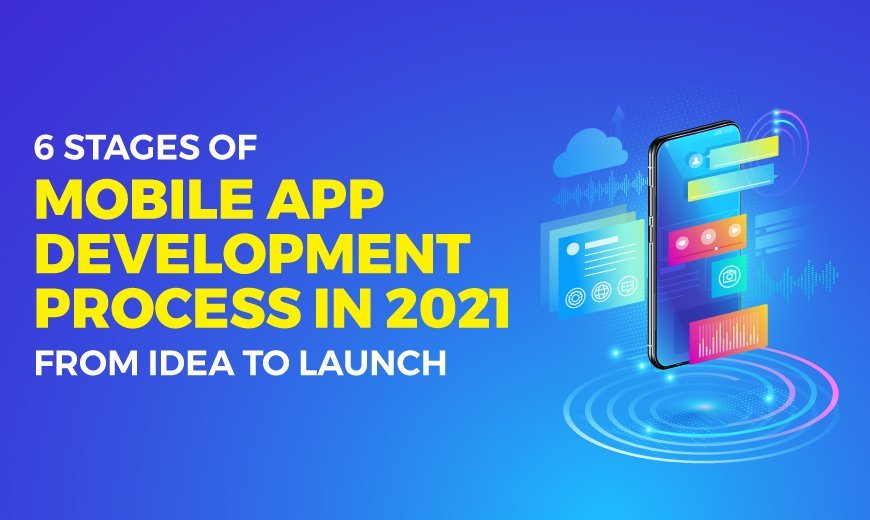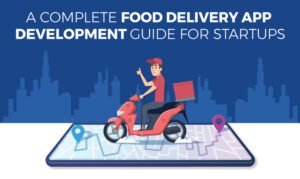
6 Stages of Mobile App Development Process in 2021 – From Idea to Launch
Table of Contents
In 2021, mobile apps are expected to generate nearly $693 billion in revenue via app stores and in-app advertising. Furthermore, enterprise mobility is assessed to be worth $510.39 billion by 2022.
While many organizations are trying to take advantage of this trend, some don’t know how to create an app effectively. Achievements within the competitive landscape of these growth and development projections can turn into a reality for your company—yet only if supported by a reliable Mobile App Development Company in Ahmedabad along with a precisely cultivated mobile app development process.
An effective app development process flow ranges more than six phases. Despite the size and scope of your project, following this development process will make your enterprise mobile app development initiative a success. Let’s take a look.
Strategy
The first step of the mobile application development process is defining the strategy for evolving your thoughts into a successful application. You may include a considerable part of this in your overall enterprise mobility strategy. As one app’s objectives may vary, there is still an app-specific effect on the mobility strategy which needs to be considered during the development process.
In this stage, you will:
- Identify the application users
- Research the competition
- Establish the app’s objectives
- Choose a mobile platform for your app
Analysis and Planning
At this stage, your app idea begins taking shape and transforms into an actual project. Analysis and planning start with defining use cases and capturing nitty-gritty functional requirements.
Once you have finalized the requirements for your Mobile App Development Solution, start preparing a product roadmap. This includes focusing on the mobile app requirements and grouping them into delivery milestones. If time, assets, or expenses are a concern, define your MVP – minimum-viable-product and focus on this for the initial launch.
Some portion of the planning phase includes identifying the skills required for your app development initiative. For instance, both iOS and Android mobile platforms utilize different development technology stacks. If you’re looking to build a mobile app for iOS and Android mobile platforms, your mobile development team needs to include iOS developers and Android developers.
UI/UX Design
To put it simply: UX (User Experience) describes how an app works, and UI (User Interface) shows how it looks. Well-designed UX and UI are essential from a business point of view. At the end of the day, they impact the retention rate. If your apps’ user experience will be charming and flawless, and the app’s design creates a positive impression on users, they will simply love it and use it.
This stage includes creating:
- Wireframes (UX)
- Designers create Wireframes that are digitally simplified visual concepts of the future application. They lay out the hierarchy, structure, and relationship between the elements that make up the product. It is a kind of app’s backbone.
- User Journey Map
- Clients, along with the mobile app development team, create a User Journey Map. It is a simple visualization of the user flow through your application. It tells the complete story of the user’s experience.
- Design (UI)
- Designers work on the visual language of your app, its style guide, User Interface, and motion design. You get mockups showing the final look of your app and videos presenting motion design (animations & screen transitions) in your app.
App Development
Planning is an essential part of this phase in the mobile app development process. Before actual development/programming efforts start, you should:
- Choose a technology stack, and
- Define the technical architecture,
- Define the development milestones.
A typical mobile app project includes three integral parts: back-end/server technology, API(s), and the mobile app front-end. After all, the objectives of the development team are not only to build a functional application but also to make an application with a pixel-perfect design that engages users.
- Mobile App Front-End
- The front-end is the native mobile app your end-user will utilize. In most cases, mobile apps comprise interactive user experiences that use an API and a back-end for managing data.
- “70% of consumers expect your mobile site and app to indulge their need for speed by being quick and easy” – Google’s Guide to Winning the Shift to Mobile.
- API
- An Application Programming Interface (API) is a communication technique between the app and a back-end server/database.
- Back-End/Server Technology
- This part incorporates database and server-side objects important for supporting functions of your mobile app. If you utilize an existing back-end platform, modifications may be needed to support the desired mobile functionality.
You can use almost any database and web programming language for the back-end. For native mobile app development, you need to pick a technology stack needed by each mobile OS platform. iOS apps can be easily developed utilizing Objective-C or Swift programming language. Android apps are basically built using Java or Kotlin.
There are many programming languages and technology stacks available for building mobile apps —the key is choosing a technology stack that is the most appropriate for your mobile app.
With platforms and devices rapidly evolving, agility is fundamental for building mobile apps within budgets and timelines. If time-to-market is your priority, utilize an agile development approach. This approach upholds frequent software releases with completed functionality.
Testing
Quality Assurance is a vital piece of each development cycle. There are several types of testing implemented during app development. The application becomes stable, secure, and usable during the testing phase of the mobile app development process. To guarantee comprehensive QA testing of your app, you have to first prepare test cases that consider all aspects of app testing.
Like how use cases drive the overall interaction of mobile app development and drive mobile app testing, test cases are used for recording testing results for software quality evaluation, performing test steps, and tracking fixes for retesting. A best practice approach is to involve your QA team in the Analysis and Design stages. The familiarity with your mobile app’s functional requirements and end goals will help produce accurate test cases.
Your app needs to undergo the following testing methods to deliver a quality mobility solution.
- User Experience Testing
- Functional Testing
- Performance Testing
- Security Testing
- Device & Platform Testing
Deployment & Support
Releasing a native mobile app demands submitting your app to the app stores such as Google Play for Android apps and Apple App Store for iOS apps. However, you will require help from a developer for Apple App Store and Google Play Store before launching your mobile app to the users.
An application’s release in the app store needs preparing metadata including:
- Your app’s title
- Description
- Keywords
- Category
- App Store screenshots
- Launch icon
After submitting in the Apple App Store, iOS apps go through a thorough review process which can take from a couple of days to several weeks relying upon the quality of your app and see if you have followed Apple’s iOS development guidelines. If your app expects users to log in, you should give Apple a test user account as an essential part of the release process.
No review process comes with Android apps, and they become available in the app store within a couple of hours of submission.
Once your application becomes available in the app stores, you can monitor its usage via mobile analytics platforms and track KPIs (Key Performance Indicators) for measuring your application’s success. Frequently check user reported issues and crash reports.
Urge users to give your company positive feedback and suggestions for your app. Prompt support for end-users and constantly fixing the app with improvements will be vital to keeping users engaged.
Conclusion
App development is a continuous process and will keep going after the initial launch as you get user feedback and build additional helpful functionality.
Sedulous has been a leading mobile app development company in India. Over the years, Sedulous has provided extensive mobile app development services to companies across finance, construction, retail, healthcare, consumer products, logistics, entertainment, and industrial engineering. We follow the same process for all of the mobile app development services in Ahmedabad that we design and develop. Following this step-by-step mobile app development process will guarantee a successful launch of your application also.
So, after going through this mobile app development process, what questions do you have about making your idea into a successful app?
Contact our mobile app experts today if you would like to discuss your mobile app development initiatives.
 +91 98792 74063
+91 98792 74063







